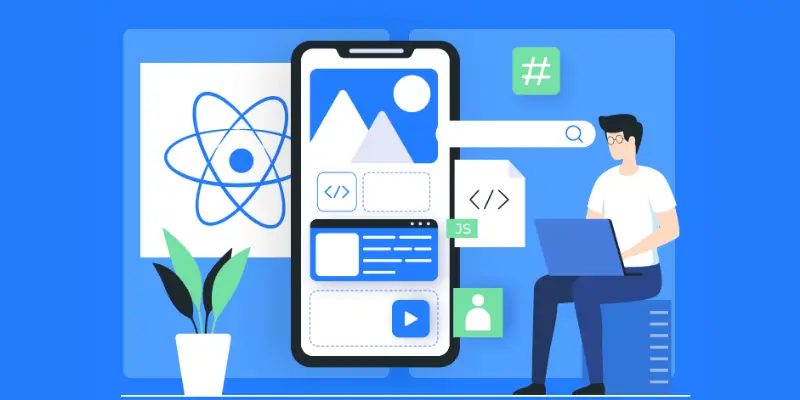Technology is quickly evolving and creating new business opportunities worldwide—2024 promises to bring sweeping transformations for all kinds of businesses. Mobile application development alone could rise to 935.22 billion dollars by 2024!
React Native, or "Native," is an open-source front-end technology developers can use to create mobile apps using React. Most people who want to make React applications do not have a clear idea about where to start development or estimations of costs for React Native projects in development.
Making high-quality applications requires both time and money. That is why organizations all over the world are investing in React Native app development as a cost-effective strategy that promotes growth and also saves both. Investing in cross-platform applications will help your company grow and reduce time and costs!
React Native is a renowned framework that lets developers develop cross-platform apps. The data obtained through Google Play or App Store indicates that it was the reason for over 14.85 percent of top download apps across the US in 2014.
Read About: Best React Native Apps in 2024: 11 App Built on React Native
What Is React Native?
React Native is a free-of-cost framework specifically designed for mobile app development developed by Meta and is quickly becoming among the top sought-after mobile platforms for iOS as well as Android developers because of its nimble tools and widgets, drastically cutting development time by as much as 90 percent!
React Native is used by several top companies in app development. Facebook, Airbnb, and Uber Eats all utilize React Native applications to service their customers efficiently.
Is React Native a Cost-Effective Option?
React Native is quickly emerging as the most popular solution for companies that want to provide exceptional user experiences and an alternative to the app market.
React Native offers many cost-cutting advantages over other solutions for the development of apps thanks to its cross-platform capabilities at its core. React Native allows one team of app developers to build applications for iOS and Android app development simultaneously, significantly decreasing labour costs by half.
React Native has made significant advances since its launch in React.js Con 2015. With growing developer interest, React Native continues to improve.
The idea was born as the first Facebook hackathon. This framework enables rapid mobile app development by sharing Web, iOS, and Android code without compromising user quality or experience.
Several big corporations - such as Facebook, Walmart, Tesla, and Bloomberg- have incorporated its unique features into their products.
Instagram, Pinterest, Discord, and Salesforce might be well-known names; React Native can be used for anything from enterprise software development to social media networks.
React Native: When is it the Best App Development Solution?
Awareness of every technology's benefits and drawbacks is vital in determining the right platform. Native is an excellent choice for developers. Native is a great choice for developers looking to update or refresh their apps or create tech alternatives.
You can reach out to one of the React Native Development Companies to discuss the requirements of your project. React Native is a fantastic option due to the following advantages:
Improve your underperforming application.
It could be due to the software being unable to perform as expected or having marketability issues. The use of outdated platforms and technology can result in this. Rebuilding or upgrading the applications with advanced technology, such as React Native, is an excellent alternative to a transition.
You should consider an open platform like React Native, which can better serve your niche's requirements and help it.
Optimizing and Rewriting Your Application
In today's fast-growing business world, technological stagnation can impede your current application's overall performance and efficiency. Moving your application to React Native will allow you to develop a new app or elevate it to a new standard.
This is an intermediate stage in optimizing your application to improve the efficiency and satisfaction of customers.
Develop MVP-Based Applications
It is crucial to be aware of this when planning your next project. This can reduce the risk. In this case, it is recommended that the MVP (minimum viable product) is utilized.
MVP is a fantastic way to gather helpful feedback from prospective users before committing to a large-scale project. React Native provides a technology solution that will make your app idea come to reality.
Factors Affecting the Cost of React Native Mobile App Development
The cost of on demand React Native app development can be contingent on various variables. A variety of factors impact the cost of creating
App complexity
The level of complexity of any mobile app depends on the features it offers and the kind of application your company chooses. The cost of developing an app increases when the features' complexity gets more complex. Here are a few types of apps that you can pick from when creating an application using react native.
-
Simple application: $10,000+
-
Database/API App: $10,000-$50,000
-
Advanced, Multi-Feature Apps: $50,000-$1,50,000
Features like Admin Panel or back-end application development. The degree of complexity in an application is defined by the following elements: BaaS, custom in-app purchases, integrations from third parties such as logins or payments, and integration with older frameworks such as enterprise applications or the kind of project.
-
API Integrations: $4,000 to $6,000.
-
Ecommerce: $1000 up to $30,000+
-
Geolocation: $10,000 - $35,000
-
Cell Phone Sensors: 2.100 sensors per
-
IoT connections: From $10,000-$50,000
Maintenance
Maintenance is an essential aspect of the expense involved in developing the React Native application. The costs of maintenance and updates are substantial over the duration of its existence. The process of updating and maintaining the app may include:
React Native apps are no different from other software. Some bugs can be discovered. These bugs must be fixed to ensure functionality and provide an enjoyable experience for users.
Businesses could include new features to satisfy user demands as their preferences and needs evolve.
Ensure compatibility with the most current editions of Operating Systems. Making sure that your app runs as expected as new operating systems are introduced is essential. It could be necessary to upgrade the application to utilize new APIs or make other modifications to ensure it is compatible.
Developer Experience and Skills
Developer costs aren't fixed. As you will observe in React Native interview questions, they're always based on the skills and experience that the developers have. It is expected to pay a higher price when your project requires the involvement of various experienced engineers or developers. Like fintech applications, apps that incorporate a variety of APIs, or complicated applications.
A majority of projects will require an engineer with a senior position. Others on the team might be intermediate programmers. Junior developers can be beneficial in helping with everyday tasks. This framework makes the creation of apps that work across different platforms using just one team.
JPLoft can help determine if your product requires junior, middle, or senior developers. The cost of other native technologies is higher because they need separate teams.
Hardware Focus
The more expensive the React Native app development services price, the higher the hardware your app connects to. The Native method is more suitable for developing IoT applications. However, React Native is more complex and costly.
App Design
To ensure that users spend as long on your application as possible, you want to ensure that your app has a well-thought-out design approach. This is a flow for users with timed animations and smooth transitions between screens. However, designing screens that keep users' attention costs money.
The cost to develop a mobile app that uses React Native is lower than that of Native apps, as only a single version of an application must be designed.
Team Size
Three aspects will influence the price to hire React Native mobile app developers
-
Hire freelancers to assist with your job.
-
Consider working with a company that has a modest capitalization.
-
If you're planning to collaborate with companies that are high-cap
Hiring freelancers to build your application is the most economical option when you select React Native. However, it won't be the most cost-effective. If you're looking to collaborate with a big agency, the cost will be expensive because that's how they operate in the marketplace.
Choosing a business with an hourly base rate of $30 to $50 would be the best option. They could be more willing to consider the idea of a new app when the cost is less.
Location of the Agency
The location is among the most critical factors determining mobile app development costs. Different app development companies charge different prices for React Native apps. The cost to hire a React Native company in the US, for example, is more expensive than the prices paid by countries located in Asia and Eastern Europe.
Distributions App
If you're considering distribution channels of the app you are considering, every channel channel will be priced differently. App stores for mobile apps charge an average of $100 for a developer license.
The host might also request that you allow the app to conform to the security guidelines and standards.
Add-Ons
Pricing is based on customized add-ons. It is possible to integrate your app that is customer-centric with various social networks or add-ons.
In general, it may cost $25,000-$60,000 to develop a React Native mobile application. The price of creating mobile applications can be contingent on many factors like the complexity of the app as well as the features that are required as well as the technology stack, the hourly rate of developers, the amount of time it takes to create code, and the distribution platform and so on.
Tips on Reducing the Costs of Native App Development
Reducing React Native costs is crucial for businesses looking to create an effective mobile app. It is possible to reduce the price associated with React Native development solutions using these suggestions:
Start with the minimum viable product
It is possible to reduce the development cost by investing time and energy into an MVP. The MVP lets you evaluate your idea quickly and quickly get user feedback. This allows you to identify the most practical features to include in future versions.
Outsourcing
Outsourcing is economical since you can employ an entire team for less than the amount you spend for them back home. It also allows you to choose from an array of talent by outsourcing.
Location
The cost directly influences the whereabouts of the development team's location. Developers in countries with high costs, like those in the United States or Western Europe, generally cost more.
Team Size
A project that is completed faster by an increased team could require more significant resources. This could result in more expensive costs. In addition, adding resources could aid in keeping a project on time. But there could be alternatives.
Brooks' Law is a rule that says that adding resources to a delayed project will only prolong the project's finalization. The concept is based on the notion that coordination and communication become more complicated when the number of people involved in an individual project rises.
Team expertise
A team with more expertise and experience can finish the project quicker and more efficiently, lowering costs. Teams with no experience or particular skills may require more time or resources to complete the project. This can result in increased expenses.
Reusable Code
You will reduce time as well as money using a code that has been test-driven.
Open-source libraries are an excellent method of including the standard features you need to add to your apps. Many open-source libraries allow you to use classic features, such as the ability to authenticate and store data. These libraries can save you time by providing code that has been tested and is ready to use.
You may also design your reusable components. The developers can create components that can be reused across different projects. This will help you avoid duplicate code and also save time.
Utilize the codebase from the previous project. If the team was involved in similar ways, you can use the identical codebase.
Cross-Platform Development
Creating apps for various operating systems from the same codebase is a great advantage. The technology was designed to aid companies in saving money by reducing the cost of labor. This technology could cut labor costs by a quarter since the same developers can simultaneously create applications that work on iOS or Android.
Development that is synchronized
Our mobile app development services cover every version of the React Native application for the targeted operating systems. This reduces the costs of developing the application and the time it takes to create.
Costs of maintenance low
The maintenance fees for React Native cover redesign changes, bugs, design changes, and app updates. But they are also open to other services. It means that one codebase needs to be maintained since the application is built to work on iOS and Android platforms. A single codebase and simple cross-platform applications reduce the expense associated with React Native mobile application development.
Ready-Made Solutions and Libraries
React Native is open-source software that includes libraries and solutions to common issues in development. Members of the community can get access to this library and solution. This makes developing a process that allows developers to write clean code easier.
Developers can develop apps faster using component libraries such as Xamarin and Xamarin components like Lottie and Teaset.
Seamless Integration of Third-Party Applications
React lets developers create customer-centric applications at a lower cost, allowing them to save time. Developers can use third-party plugins that will enable them to add features to the two platforms (iOS and Android) with minimal effort. React Native allows developers to seamlessly integrate modules within the module to develop feature-rich, speedy, and seamless mobile applications.
Factors that Cause the Cost-intensive Development of Native Apps with React Native Apps
These are the elements that affect the cost of the React Native application. Understanding these aspects will assist you in optimizing your expenses while ensuring the durability and scalability of the application.
UI restrictions
The use of a standard code that is used for Android and iOS could negatively impact the app. Applications that share a joint code base appear the same across different platforms.
Optimizing Performance
Performance is the most significant distinction between React Native apps and Native Apps. Native apps come with an app that uses technology to enhance users' experience. The process of bringing React Native up to Native app standards is costly.
Learn New Frameworks
React Native has a low learning curve. However, developers need to master React Native. React Native frameworks.
Security Assurance
React Native development is not as secure as Native applications. This could be a significant issue if there is a security breach. The solution is to put money into an international team of QA experts.
Benefits of React Native App
Here are a few benefits of native React apps:
1. Less expensive than Native Development
You only need the ability to develop an application using JavaScript once; you can do this with React Native. A native technique, however, requires creating two apps entirely from scratch. One app is designed for iOS, and another is designed for Android. Since React Native demands the writer to write only one line of code, it is necessary to have two developers to reduce twice the cost of building and maintaining the app.
2. Third-Party Plugin Support
Some components are not included in the core components of the React Native Framework. The framework ensures that developers can access plugins available for other third-party developers, like JavaScript modules and native ones, for compensation. For example, if developers want to incorporate Google Maps into their projects, React Native allows them to integrate the plugin into native or third-party modules.
3. Excellent Performance
Native apps that respond to native requests operate like native apps developed on iOS or Android platforms. Additionally, they are fast because the programming language used for mobile devices is designed to be optimized. Instead of using CPU for the majority of their work, React Native applications make use of their Graphical Processing Unit (GPU). This means they are much faster than hybrid technologies on multiple platforms.
4. Increased Stability and Reliability
It is also crucial to simplify the data binding process to guarantee that parent data is protected and the child component doesn't modify it, making applications reliable and stable. If you want to change an item, the developer must alter their settings before updates are applied continuously. This process will keep the elements from being upgraded.
5. Moveable
If app developers wish or need to transfer their app to a different development platform for future development, they don't need to create a new app all over again. The app can be exported into Android Studio or Xcode from React Native. This is one of the significant benefits of adopting React Native to develop mobile apps. It also increases the versatility and flexibility of this framework.
6. JavaScript
Based on a Statista study, JavaScript is widely used by programmers all over the globe. About 68% of the respondents utilize JavaScript, as per the analysis. Since React Native is built in JavaScript, the developers don't have any reason not to use the technology.
7. Existing App Enhanced
Are you using an existing app but would like to make it more cost-effective? It is possible to attach React Native UI components to an existing application without needing to rewrite it altogether. This is useful when you only want to improve an existing app instead of completely overhauling the entire application.
Conclusion
Mobile app development is the method businesses worldwide opt to use to increase their efficiency and productivity and expand in the long term. Many companies face the dilemma of deciding between a native or cross-platform application that meets their requirements.
It is the React Native framework that allows businesses to develop mobile applications using JavaScript, which is a single programming language. React Native's services enable app developers to use the benefits of cross-platform development without compromising safety or speed.
Only when you work with a professional experienced and certified in React native application development will you get this type of enhancement to your business.
JPLoft, a reputable and well-known React native app development company, can help you put things into perspective and estimate the costs of creating a mobile application. Contact our experts if you are thinking of launching a new business idea!
FAQs
1. Does React Native only work for mobile applications?
The Open-Source JavaScript Framework creates applications for various platforms, including Android, Android TV and iOS, macOS, Windows, Web, and UWP. It lets developers create a code base shared for multiple platforms and applications.
2. What does the future hold in React Native App Development?
React Native has a bright future for the development of mobile apps. It offers improved app performance, a dazzling user experience, and strong community support.
3. Other frameworks do you have available to run cross-platform applications?
Flutter Ionic, Flutter, and Xamarin are three other frameworks available for cross-platform application development that can be utilized to build robust applications. These frameworks allow for faster development and also excellent performance for your application.
4. Does React Native make sense for your app project?
This is contingent on the needs and expectations of your company application. React Native is an example. It is an excellent option if you want to join the Android or iOS market with a lower budget and fewer deadlines. It's not the ideal choice if you're trying to integrate multiprocessing or the most recent native components into developing architecture.
5. What is the Power and Effectiveness of React Native?
It is an open-source framework that can be employed to develop mobile apps. It has proven effective as a perfect cross-platform companion and has gained popularity among developers due to its ability to reduce time and money.












Share this blog